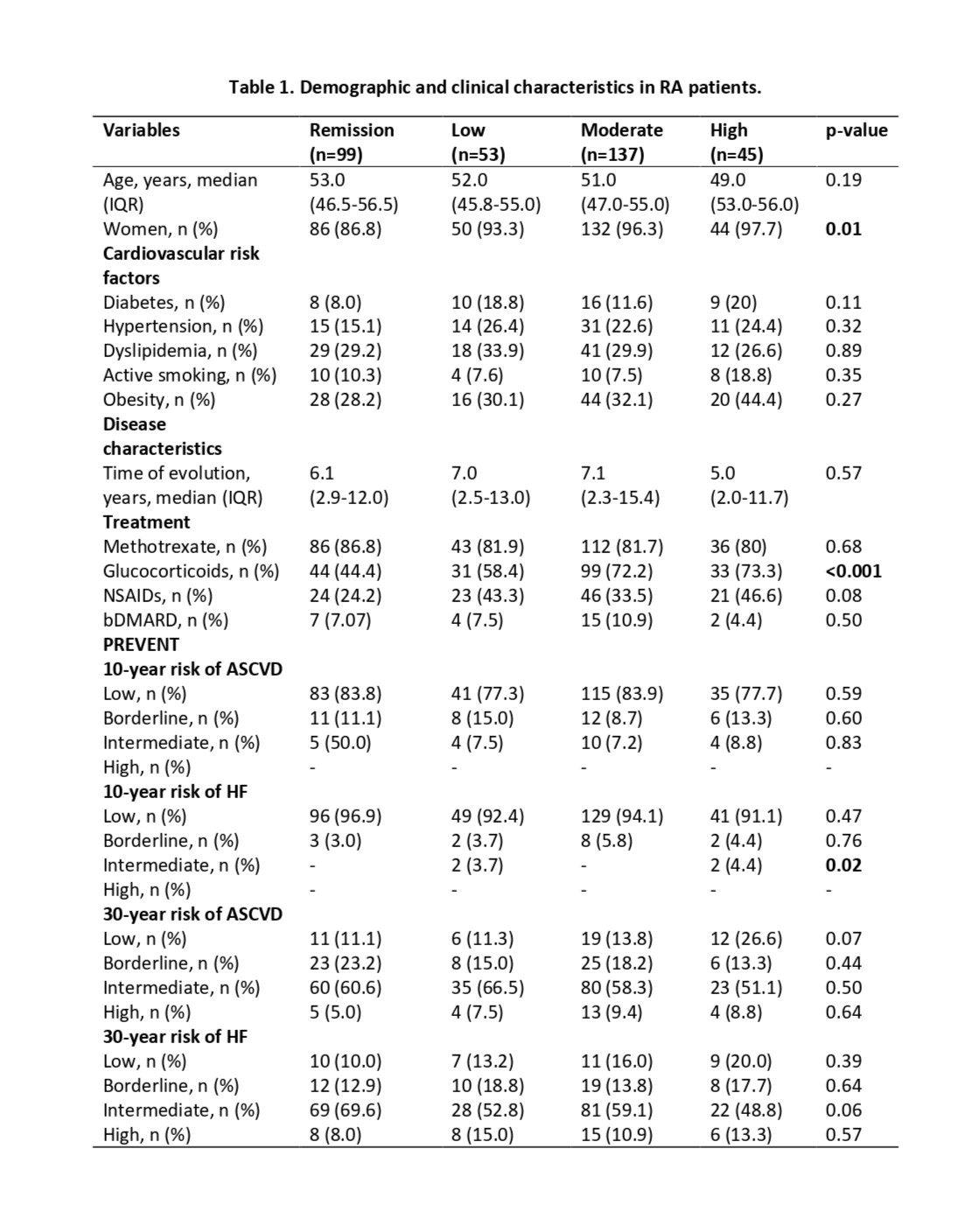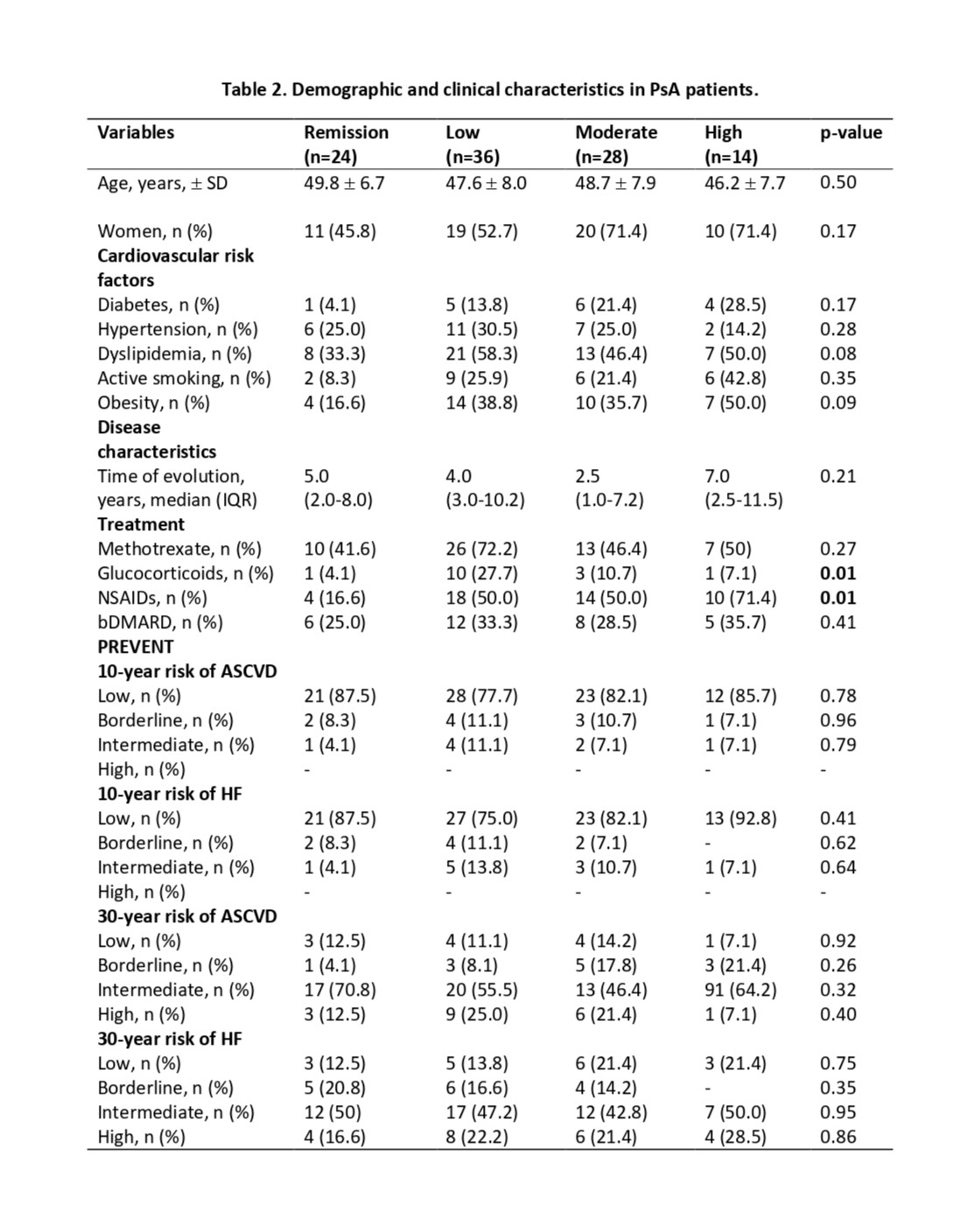Session Information
Session Type: Poster Session A
Session Time: 10:30AM-12:30PM
Background/Purpose: The American Heart Association’s PREVENT (Predicting Risk of Cardiovascular Disease EVENTs) is a new calculator developed in 2024, which estimates the 10- and 30-year risk of Atherosclerotic Cardiovascular Disease (ASCVD) and Heart Failure (HF). Prior research has shown that patients with rheumatoid arthritis (RA) and psoriatic arthritis (PsA) exhibiting moderate or high disease activity face a heightened cardiovascular risk. Previous cardiovascular disease calculators are inaccurate in determining the risk in these patients, making the precise estimation an unmet need. We aimed to evaluate the association between disease activity and cardiovascular risk in RA and PsA patients by integrating the new PREVENT calculator.
Methods: We performed a cross-sectional and comparative study including RA and PsA patients aged 40 to 60 who fulfilled the 2010 ACR/EULAR and 2006 CASPAR criteria, respectively. Patients with previous cardiovascular disease, pregnancy, and overlap syndrome were excluded. RA patients were divided into four groups according to their disease activity by Disease Activity Score-28 for RA with C-Reactive Protein (DAS28-CRP) and PsA patients by Disease Activity Psoriatic Arthritis (DAPSA). We calculated the 10 and 30-year risk of ASCVD and HF by PREVENT. Only the 10-year risk of ASCVD in RA was multiplied by 1.5 according to the 2015/2016 EULAR update. Cardiovascular risk was categorized according to PREVENT classification. The Kolmogorov–Smirnov test was employed to determine normality. Comparisons with Chi-square, ANOVA, or Kruskal-Wallis test, accordingly. A p-value of ≤0.05 was considered statistically significant.
Results: A total of 334 RA and 102 PsA patients were included. Most participants were women (RA n= 312, 93.4%, PsA n=60, 55%) with a similar mean age across all groups (53.8 ± 10.8). There was no difference in traditional cardiovascular risk factors between groups. Despite the activity of the disease, the majority of the patients were classified as low risk for 10-year ASCVD and HF. In the RA intermediate 10-year risk category for HF, a significant difference was noted between the low and high disease activity groups (3.7% vs. 4.4%, p=0.02), though this may be due to the small sample size (Table 1). In PsA patients with high disease activity, disease duration was longer (7.0 years, p=0.21) and showed a higher classification for low risk of 10-year ASCVD and HF (85.7% and 92.8%, respectively) (Table 2). No patients were categorized as high risk 10-year of ASCVD or HF. There were no significant differences between groups and even with lower disease severity, a higher number of patients are projected to have an intermediate, and high risk for ASCVD and HF over 30 years according to the PREVENT algorithm.
Conclusion: Our study did not find an association between disease severity and increased cardiovascular risk mediated by PREVENT in RA or PsA patients. However, managing disease activity and attaining remission in these patients is recommended, integrating individual characteristics to avoid the future onset of subclinical atherosclerosis and, consequently, cardiovascular events.
To cite this abstract in AMA style:
Gonzalez Melendez A, Polina-Lugo R, Elizondo-Benitez M, Guajardo Aldaco A, Uresti O, de la Rosa-Vazquez R, Colunga Pedraza I, Galarza-Delgado D, Azpiri-Lopez j, Arvizu-Rivera R, Cardenas-de la Garza J. Cardiovascular Risk Estimated with the New PREVENT Calculator and Disease Activity in Patients with Rheumatoid and Psoriatic Arthritis [abstract]. Arthritis Rheumatol. 2024; 76 (suppl 9). https://acrabstracts.org/abstract/cardiovascular-risk-estimated-with-the-new-prevent-calculator-and-disease-activity-in-patients-with-rheumatoid-and-psoriatic-arthritis/. Accessed .« Back to ACR Convergence 2024
ACR Meeting Abstracts - https://acrabstracts.org/abstract/cardiovascular-risk-estimated-with-the-new-prevent-calculator-and-disease-activity-in-patients-with-rheumatoid-and-psoriatic-arthritis/


